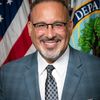Public education is one of America’s greatest superpowers.
It has paved the way for our nation’s astronauts and authors, engineers and musicians, nonprofit advocates and government leaders. At its very best, it opens doors of opportunity for Americans all over this country ― showing students they can achieve big dreams regardless of their race, place or economic standing ― creating a powerful foundation for our nation’s global leadership and competitiveness. That promise is what motivates me ― as the parent of two children who learned and grew up in local public schools, a lifelong teacher and now as secretary of education.
But as we commemorate American Education Week this week, we also know that our current education system has been falling far short of that promise for decades, failing too many of our students. That’s unacceptable. Our Raise the Bar: Lead the World agenda at the U.S. Department of Education calls for raising the bar for our education system to the level our nation needs if we want to lead the world instead of returning to the low bar of our education system as it was in 2019 ― by focusing on substance, not sensationalism, in education.
Here’s what that looks like.
Speaking as a parent myself, I know one of the first things you want to know as your children start their educational journey is if they are learning reading and math at high levels? Do they have a highly qualified teacher in their classroom who is trained in rigorous literacy and numeracy approaches? That’s why we need to invest in building up the teacher pipeline alongside tutoring, mentoring, after-school programs and other investments that can support students’ academic excellence. We have seen 28 states and Puerto Rico embrace registered teaching apprenticeships that provide student teachers with crucial on-the-job experience while getting paid. Twenty-nine states and the District of Columbia have also increased teacher salaries ― absolutely critical if we want great teachers to join, and stay in, this profession.
As parents well understand, learning conditions also matter a great deal. If your child doesn’t feel safe or healthy, mentally or physically, it’s much harder for them to focus and learn. At a time when the surgeon general has called mental health the “defining public health crisis of our time” and about 1 in 3 high school girls has seriously considered suicide, there can be no serious vision for education that doesn’t make student health and mental health a top priority.
Under our watch, we’ve seen states and school districts leverage the landmark Bipartisan Safer Communities Act to hire more school counselors (resulting in a 43% increase in school social workers), build mental health clinics within schools and integrate mental health and wellness periods into school days. We’re working with states to ensure they can receive long-term Medicaid reimbursement that is available for school-based health and mental health services. So far, 25 states have done so.
As a parent of one student in college now and another graduating soon from high school, I also know from experience that a big question on your mind may be if your child will graduate from high school with great options for a rewarding life and career? Too many of our high schools are stuck in the broken model of the last century, designed around the narrowest of pathways: four-year college or bust.
It’s far past time to evolve our high schools so students have more options, not less, to pursue their passions and their careers. We see a future where every high school has a dual enrollment program with a local university so students can explore advanced college classes and gain credits ― alongside opportunities for workforce internships, credentials in high-demand skills, career-connected courses, college and career advising, developing multilingualism, and more.
It’s also why this administration has been fighting to fix a broken higher education system and make college more affordable and accessible ― so more students can take advantage of a college education if that is the right choice for them. College should not be a life sentence of debt. We are fixing that!
Some wonder why our educational agenda does not have the sensationalism of the shiny new top-down federal initiatives of the past that have come and gone. As a former teacher and school principal, I know that we do not need someone from Washington giving local districts more to do while parents and educators urgently address the academic and mental health needs of our students. What schools need is substance in those areas that we know work to improve student outcomes. That’s what we deliver with Raise the Bar: Lead the World.
If we can collaborate and invest at the federal, state and local levels in each of these areas ― academic excellence, learning conditions and pathways to college and careers ― we have the chance to dramatically transform public education in America for the better ― to raise the bar. That will position our nation to compete globally and lead the world for years to come.
We will do it.

